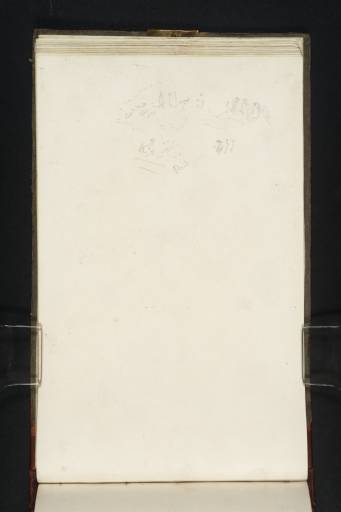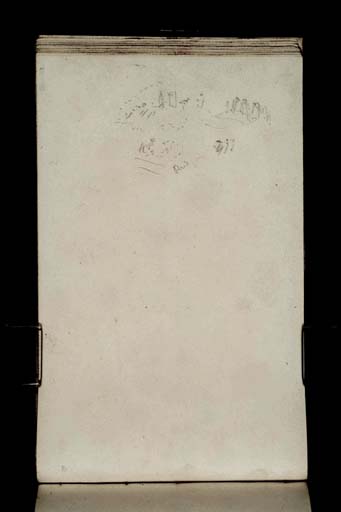Joseph Mallord William Turner Part of the Ceremony of the Laying of the Foundation Stone of the National Monument, Calton Hill 1822
Image 1 of 2
Joseph Mallord William Turner,
Part of the Ceremony of the Laying of the Foundation Stone of the National Monument, Calton Hill
1822
Joseph Mallord William Turner 1775–1851
Folio 22 Verso:
Part of the Ceremony of the Laying of the Foundation Stone of the National Monument, Calton Hill 1822
D17540
Turner Bequest CC 22a
Turner Bequest CC 22a
Pencil on white wove paper, 187 x 114 mm
Inscribed in pencil by Turner ?‘Red’ upper centre
Blindstamped with the Turner Bequest stamp upper centre right
Inscribed in pencil by Turner ?‘Red’ upper centre
Blindstamped with the Turner Bequest stamp upper centre right
Accepted by the nation as part of the Turner Bequest 1856
References
1909
A.J. Finberg, A Complete Inventory of the Drawings of the Turner Bequest, London 1909, vol.I, p.611, CC 22a, as ‘A slight sketch’.
1981
Gerald Finley, Turner and George the Fourth in Edinburgh 1822, exhibition catalogue, Tate Gallery, London 1981, pp.30, 82, [110] reproduced as ‘Ceremony of the laying of the foundation stone of the National Monument, seen from Nelson’s Monument, Calton Hill’.
1984
Martin Butlin and Evelyn Joll, The Paintings of J.M.W. Turner, revised ed., New Haven and London 1984, p.153.
This slight and rapidly executed sketch, drawn at the outer edge of the page with the sketchbook turned to the right is the first of eight such sketches of the ceremony of the laying of the foundation stone of the National Monument on Calton Hill.
The sketches, all but one of which were made at the outer edges of seven verso pages (with the last made on the recto of the eighth) were drawn in a unique shorthand style that makes use of a pared-down system of signs. The present sketch is made up almost entirely of short dots and dashes with a few larger lines and circular shapes. Without the context of the following seven sketches little would be discernable in this sketch other perhaps than the row of figures at the top right – their matchstick forms being a conventional enough sign for people. The other parts of the sketch require comparison with other drawings and written accounts of the event in order to decipher it.
Butlin and Joll’s interpretation of the drawing as related to the unnumbered composition on folio 43 verso of the King at Edinburgh sketchbook (Tate D40979; Turner Bequest CCI 43a) which is preparatory for the painting, George IV at the Provost’s Banquet, circa 1822 (Tate N02858),1 is therefore understandable. The mistake presumably arises from the row of figures at the top right who bear a compositional similarity to the figures at the King’s table in the banquet painting. Beneath them is another row of matchstick figures who could be the attendants in the painting, and to the left a row of dots and dashes recall the heads of other guests sitting at parallel rows of tables. The context of the subsequent seven drawings, however, to which this is stylistically very similar, makes this interpretation impossible. By the arrangement of those figures, their costumes (notably their hats and other accessories which would not have been worn indoors), and the presence of various other identifiable elements, these sketches can be seen not to be of the banquet but of the foundation stone ceremony.
The sketches were all made from an elevated position to the south of the site, which Finley has identified as the top of Nelson’s Monument – a privileged vantage point that Turner must have had arranged for him by an influential figure such as Charles Robert Cockerell or perhaps even Sir Walter Scott.2 A drawing of Holyrood House and Abbey on folio 37 (D17566) may also have been made from this vantage point on this occasion. By examining the sketches in sequence and considering their position in the sketchbook Finley has also come up with an explanation for their style:
Since Turner had settled on the difficult objective of recording the ceremony’s shifting configurations, he required a technique of rapidly recording these. He therefore turned his sketchbooks at right angles [sic] to his body and made small confined sketches on the upper page at its outer limit3
The scene shows the site of the foundation stone which was laid at the base of the southern side of the proposed building on Calton Hill. Groups of people involved in the ceremony stand or sit on platforms that were erected to the east and west of the stone while others stand around. A rectangular shape at the top left represents the dome of the City Observatory. It is not clear exactly what the other dots and dashes are intended to represent in this instance. The observatory is not depicted again in this series of sketches, although it does feature in two other sketches associated with the event: folios 33 in this sketchbook (D17558) and as composition ‘17’ in the proposed ‘Royal Progress’ series in the King at Edinburgh sketchbook (Tate D40979; Turner Bequest CCI 43a). The platform, however, and the row of seated figures at the top right do feature in most of the other sketches of the series: folios 23 verso, 24 verso, 25 verso, 26 verso, 27 verso, 28 verso and 29 (D17542, D17544, D17546, D17548, D17550, D17552, D17543).
Thomas Ardill
October 2008
How to cite
Thomas Ardill, ‘Part of the Ceremony of the Laying of the Foundation Stone of the National Monument, Calton Hill 1822 by Joseph Mallord William Turner’, catalogue entry, October 2008, in David Blayney Brown (ed.), J.M.W. Turner: Sketchbooks, Drawings and Watercolours, Tate Research Publication, December 2012, https://www


